Aspectos de Seguridad en la Web
Our current view of security

- until now, we have assumed:
- valid user input
- non-malicious users
- nothing will ever go wrong
- this is unrealistic!
The real world

- in order to write secure code, we must assume:
- invalid input
- evil users
- incompetent users
- everything that can go wrong, will go wrong
- everybody is out to get you
- botnets, hackers, script kiddies, KGB, etc. are out there
- assume nothing; trust no one
Attackers' goals

Why would an attacker target my site?
- Read private data (user names, passwords, credit card numbers, grades, prices)
- Change data (change a student's grades, prices of products, passwords)
- Spoofing (pretending to be someone they are not)
- Damage or shut down the site, so that it cannot be successfully used by others
- Harm the reputation or credibility of the organization running the site
- Spread viruses and other malware
- Stolen Data Cyber-criminals frequently hacks visitor’s data that is stored on a website like email addresses, payment information, and a few other details.
- Phishing schemes hackers design a layout that looks exactly like the website to trick the user by compelling them to give their sensitive details.
- Session hijacking cyber attackers can take over a user’s session and compel them to take undesired actions on a site.
- Malicious redirects the attacks can redirect visitors from the site they visited to a malicious website.
Tools that attackers use
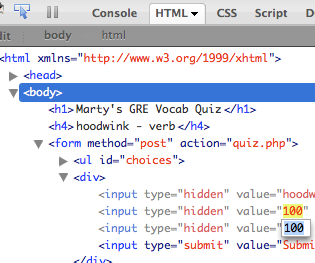
Assume that the attacker knows about web dev and has the same tools you have:
- Firebug
- extensions e.g. Web Dev Toolbar
- port scanners, e.g. nmap
- network sniffers, e.g. Wireshark, EtherDetect, Firesheep
Some kinds of attacks

- Denial of Service (DoS): Making a server unavailable by bombarding it with requests.
- Social Engineering: Tricking a user into willingly compromising the security of a site (e.g. phishing).
- Privilege Escalation: Causing code to run as a "privileged" context (e.g. "root").
- Information Leakage: Allowing an attacker to look at data, files, etc. that he/she should not be allowed to see.
- Man-in-the-Middle: Placing a malicious machine in the network and using it to intercept traffic.
- Session Hijacking: Stealing another user's session cookie to masquerade as that user.
- Cross-Site Scripting (XSS) or HTML Injection: Inserting malicious HTML or JavaScript content into a web page.
- SQL Injection: Inserting malicious SQL query code to reveal or modify sensitive data.
Information leakage
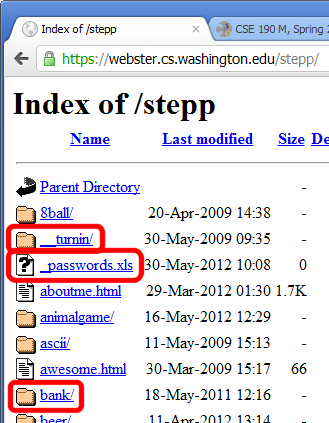
when the attacker can look at data, files, etc. that he/she should not be allowed to see
-
files on web server that should not be there
- or have too generous of permissions (read/write to all)
-
directories that list their contents (indexing)
- can be disabled on web server
-
guess the names of files, directories, resources
- see
loginfail.php, tryloginsuccess.php - see
user.php?id=123, tryuser.php?id=456 - see
/data/public, try/data/private
- see
Man-in-the-middle attack
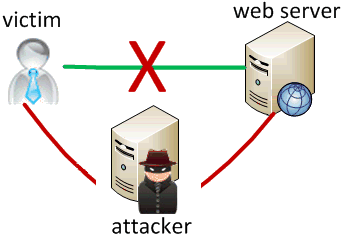
when the attacker listens on your network and reads and/or modifies your data
- works if attacker can access and compromise any server/router between you and your server
- also works if you are on the same local area network as the attacker
- often, the attacker still sends your info back and forth to/from the real server, but he silently logs or modifies some of it along the way to his own benefit
- e.g. listens for you to send your user name / password / credit card number / ...
Secure HTTP (HTTPS)
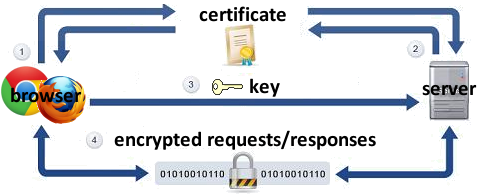
- HTTPS: encrypted version of HTTP protocol
- all messages between client and server are encrypted so men in the middle cannot easily read them
- servers can have certificates that verify their identity
Session hijacking

when the attacker gets a hold of your session ID and masquerades as you
-
exploit sites that use HTTPS for only the initial login:
- HTTPS: browser → server (POST login.php)
- HTTPS: browser ← server (login.php + PHPSESSID cookie)
- HTTP: browser → server (GET whatever.php + PHPSESSID cookie)
- HTTP: browser ← server (whatever.php + PHPSESSID cookie)
- attacker can listen to the network, get your session ID cookie, and make requests to the same server with that same session ID cookie to masquerade as you!
- example: Firesheep
HTML injection
a flaw where a user is able to inject arbitrary HTML content into your page

- This flaw often exists when a page accepts user input and inserts it bare into the page.
- example: magic 8-ball (8ball.html)
- What kinds of silly or malicious content can we inject into the page? Why is this bad?
Injecting HTML content
8ball.php?question=<em>lololol</em>
- injected content can lead to:
- annoyance / confusion
- damage to data on the server
- exposure of private data on the server
- financial gain/loss
- end of the human race as we know it
- why is HTML injection bad? It allows others to:
- disrupt the flow/layout of your site
- put words into your mouth
- possibly run malicious code on your users' computers
Cross-site scripting (XSS)
a flaw where a user is able to inject and execute arbitrary JavaScript code in your page
8ball.php?question=<script type='text/javascript'>alert('pwned');</script>
- JavaScript is often able to be injected because of a previous HTML injection
-
Try submitting this as the 8-ball's question in Firefox:
-
<script type="text/javascript" src="http://panzi.github.com/Browser-Ponies/basecfg.js" id="browser-ponies-config"></script><script type="text/javascript" src="http://panzi.github.com/Browser-Ponies/browserponies.js" id="browser-ponies-script"></script><script type="text/javascript">/* <![CDATA[ */ (function (cfg) {BrowserPonies.setBaseUrl(cfg.baseurl);BrowserPonies.loadConfig(BrowserPoniesBaseConfig);BrowserPonies.loadConfig(cfg);})({"baseurl":"http://panzi.github.com/Browser-Ponies/","fadeDuration":500,"volume":1,"fps":25,"speed":3,"audioEnabled":false,"showFps":false,"showLoadProgress":true,"speakProbability":0.1,"spawn":{"applejack":1,"fluttershy":1,"pinkie pie":1,"rainbow dash":1,"rarity":1,"twilight sparkle":1},"autostart":true}); /* ]]> */</script>
-
- injected script code can:
- masquerade as the original page and trick the user into entering sensitive data
- steal the user's cookies
- masquerade as the user and submit data on their behalf (submit forms, click buttons, etc.)
- ...
Another XSS example
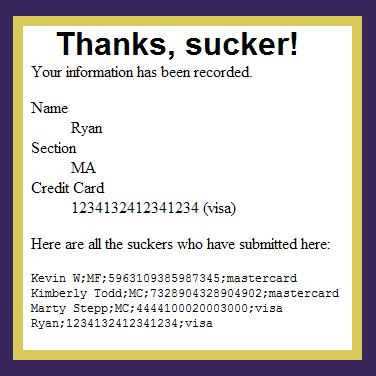
- example: Lab 4, Buy-a-Grade (buyagrade.html)
- Recall that the user submits his name, section, and credit card number to the server, which are then displayed on the page.
- How can we inject HTML/JavaScript into the page? Why is this bad?
- What could we do to steal the user's sensitive information?
Securing against HTML injection / XSS
- one idea: disallow harmful characters
- HTML injection is impossible without < >
- can strip those characters from input, or reject the entire request if they are present
- another idea: allow them, but escape them
htmlspecialchars
|
returns an HTML-escaped version of a string |
$text = "<p>hi 2 u & me</p>";
$text = htmlspecialchars($text); # "<p>hi 2 u & me</p>"
SQL injection

a flaw where the user is able to inject arbitrary SQL into your query
- This flaw often exists when a page accepts user input and inserts it bare into the query.
- example: simpsons grade lookup (start.php)
- What kinds of SQL can we inject into the query? Why is this bad?
A SQL injection attack
-
The query in the Simpsons PHP code is:
$query = "SELECT * FROM students WHERE username = '$username' AND password = '$password'";
- Are there malicious values for the user name and password that we could enter?
- Password:
-
This causes the query to be executed as:
$query = "SELECT * FROM students WHERE username = '$username' AND password = '' OR '1'='1'";
- What will the above query return? Why is this bad?
Too true...

- injected SQL can:
- change the query to output others' data (revealing private information)
- insert a query to modify existing data (increase bank account balance)
- delete existing data (
; DROP TABLE students; --) - bloat the query to slow down the server (
JOIN a JOIN b JOIN c ...) - ...
Securing against SQL injection
- similar to securing against HTML injection, escape the string before you include it in your query
quote
|
returns a SQL-escaped version of a string |
$username = $db->quote($_POST["username"]); $password = $db->quote($_POST["password"]); $query = "SELECT name, ssn, dob FROM users WHERE username = $username AND password = $password";
- replaces
'with\', etc., and surrounds with quotes
Takeaway Lessons
- You are never safe, assume everyone is malicious
- Use
htmlspecialchars()and$db->quote()where appropriate - Do not trust raw user-generated data!
- Do not trust raw user-generated data!!
- DO NOT TRUST RAW USER-GENERATED DATA!!!
- DO NOT TRUST RAW USER-GENERATED DATA!!!!